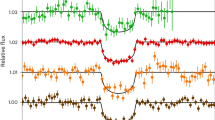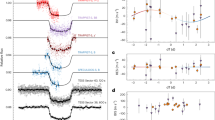Abstract
FOLLOWING the announcement of the discovery of a ring around Jupiter by the Voyager spacecraft1 a successful attempt was made to detect the reflected sunlight from this ring at 2.2µm. We describe here the results of this experiment and the precautions taken to separate the radiation from the ring and the scattered radiation from the planet.
This is a preview of subscription content, access via your institution
Access options
Subscribe to this journal
Receive 51 print issues and online access
$199.00 per year
only $3.90 per issue
Buy this article
- Purchase on Springer Link
- Instant access to full article PDF
Prices may be subject to local taxes which are calculated during checkout
Similar content being viewed by others
References
Honolulu Advertiser, (8 March 1979); IAU Circ. No. 3338 (1979); Smith, B. A. et al. Science 204 (in the press).
Danielson, R. E. Astrophys. J. 143, 949 (1966).
Author information
Authors and Affiliations
Rights and permissions
About this article
Cite this article
BECKLIN, E., WYNN-WILLIAMS, C. Detection of Jupiter's ring at 2.2 µm. Nature 279, 400–401 (1979). https://doi.org/10.1038/279400a0
Received:
Accepted:
Published:
Issue Date:
DOI: https://doi.org/10.1038/279400a0
This article is cited by
-
New progress in the physical studies of the planetary rings
Space Science Reviews (1980)
-
On the Pioneer 11 observation of the ring of Jupiter
Nature (1979)
Comments
By submitting a comment you agree to abide by our Terms and Community Guidelines. If you find something abusive or that does not comply with our terms or guidelines please flag it as inappropriate.



